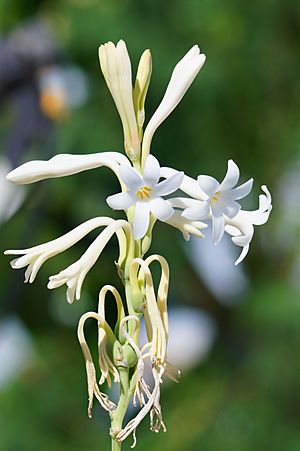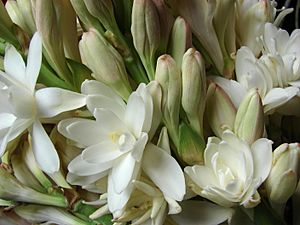Tuberose facts for kids
Quick facts for kids Tuberose |
|
|---|---|
 |
|
| Scientific classification | |
| Synonyms | |
|
The tuberose (scientific name: Agave amica) is a beautiful flowering plant. It used to be called Polianthes tuberosa. This plant is a perennial, meaning it lives for more than two years. It belongs to the Asparagaceae family, which also includes asparagus! People love its strong, sweet smell. Because of its amazing scent, extracts from the tuberose are used to make perfume. This plant is now grown all over the world. It originally came from Mexico.
Contents
Where Does the Name 'Tuberose' Come From?
The name "tuberose" comes from the Latin word tuberosa. This word means "swollen" or "tuberous." It describes the plant's special root system. These roots are like small, swollen storage parts, similar to a potato.
What Does the Tuberose Look Like?
The tuberose is a herbaceous plant. This means it has soft, green stems, not woody ones like a tree. It grows from underground tubers or thick roots. These tubers help the plant store food and water. New plants can also grow from these tubers.
Its leaves are a dull green color. They are about 1 to 1.5 feet (30 to 45 cm) long. At the bottom, they can be up to 0.5 inches (1 cm) wide. The leaves are a bit succulent, meaning they are slightly thick and juicy.
The flowers grow on a tall stalk called a spike. This spike can reach up to 3 feet (about 1 meter) high. The flowers are pure white and look waxy. They are shaped like tubes, about 2.5 inches (6 cm) long. At the end, the tube opens up into six parts called tepals. These flowers have a very strong, lovely smell. Inside the flower, there are six stamens, which produce pollen. There is also a three-part stigma, which receives pollen.
There is a popular type called 'The Pearl'. It has double flowers, meaning it has more petals. This type has wider, darker leaves. Its flower spikes are shorter, usually 1.5 to 2 feet (45 to 60 cm) tall. While most tuberoses are white, some have orange flowers. Scientists have also created yellow, pink, red, and greenish types by crossing different plants.
How Scientists Named the Tuberose
Scientists first described the tuberose in 1753. Carl Linnaeus, a famous scientist, named it Polianthes tuberosa. Later, in 1790, another scientist named Friedrich Kasimir Medikus gave it a different name, Tuberosa amica.
Over time, scientists learned more about plants. They used both how plants look and their DNA to understand their relationships. These studies showed that Polianthes actually belongs inside a larger group of plants called Agave. So, the tuberose is now part of the Agave family.
When plants move to a new group, their scientific name sometimes changes. There were a couple of tries to name the tuberose within the Agave group. But because of special naming rules, these names were not quite right. Finally, in 2017, scientists Joachim Thiede and Rafaël Govaerts gave it the correct name: Agave amica. This is the official scientific name used today.
Where Does the Tuberose Grow?
Scientists believe the tuberose originally grew in central and southern Mexico. You won't find it growing wild there anymore. This is probably because the Aztecs started growing it for their own use a long time ago. They "domesticated" it, meaning they brought it into cultivation. Today, tuberoses are grown in many warm and mild countries around the world.
Uses of the Tuberose
In Perfumery
The amazing smell of the tuberose has been used in perfumes for a very long time. People started making perfume from it in the 1600s. This was when the flower first came to Europe.
Marie Antoinette, a French queen, used a perfume with tuberose in it. It was called Sillage de la Reine. Tuberose is still a popular scent in perfumes today. It can be the main smell in a perfume or mixed with other flower scents. However, its smell is very strong. Perfume makers must use it carefully so it doesn't become too overpowering.
Other Uses
In India and Bangladesh, tuberoses are very popular. People use them to make beautiful flower garlands. These garlands are offered to gods or used as decorations at weddings.
While tuberoses were once used mostly for funerals, they are now used in flower arrangements for many happy occasions too.
In Indonesia, tuberose flowers are even used in cooking!
In Hawaii, tuberoses are one of the main flowers used to make leis. Leis are special necklaces made of flowers. Other flowers used for leis include plumerias, ginger, orchids, and pikake (jasmine).
How to Grow Tuberoses
You can grow tuberoses outdoors all year in places with warm winters. These are called hardiness zones 8-10. In colder areas, people grow tuberoses as summer plants. They plant them in pots or in flower gardens. This way, they can enjoy their wonderful scent.
To make flowers, tuberose plants need about four months of warm weather. This starts from when you plant their roots (rhizomes). Gardeners often start the rhizomes indoors in pots. They do this in a greenhouse during late winter or early spring. Then, they move the plants outside in late spring. This is after all danger of frost has passed. If you plant them directly in the ground too late, they might not bloom until September. This means you get less time to enjoy their flowers.
When the leaves start to turn yellow in October, you should cut them off. Then, dig up the rhizomes. Store them in a cool, dry, and dark place for the winter. You can plant them again next spring!
The most popular type of tuberose is 'The Pearl'. It has double flowers and grows about 2.5 feet (75 cm) tall. Its buds are pale pink, and they open into creamy white flowers. Another common type is 'Mexican Single'. It might not look as fancy as 'The Pearl'. However, its flowers last longer when cut and put in a vase.
Louis XIV, a king of France, loved tuberoses very much. He had hundreds of them planted at his palace in Versailles. They were in the flower beds of the Grand Trianon. The scent was so strong it filled the air! The plants were grown in clay pots. They were planted directly into the ground. To keep the perfume strong, new plants were brought in often, sometimes every day.
Gallery
See also
 In Spanish: Agave amica para niños
In Spanish: Agave amica para niños









